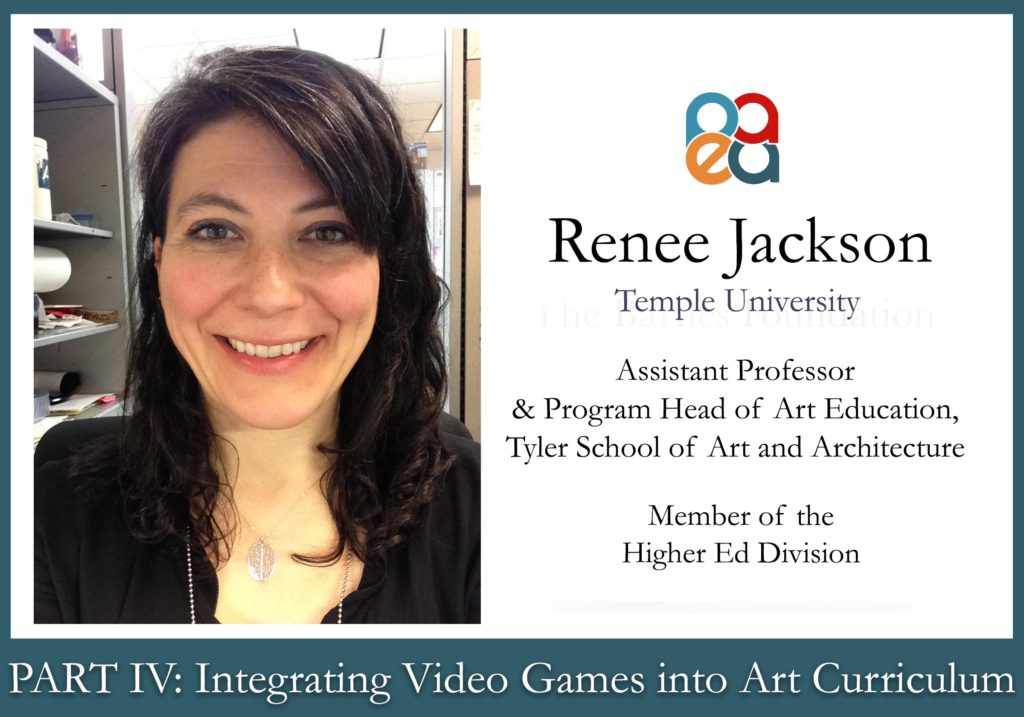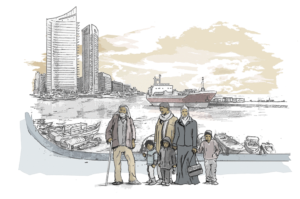PART IV: INTEGRATING VIDEO GAMES INTO ART CURRICULUM
Gaming your Pedagogy:
Taking inspiration from games, toys, and play in the art classroom
Renee Jackson is an Assistant Professor and Program Head of Art Education at Tyler School of Art and Architecture, in the Art Education and Community Arts Practices Department at Temple University. She is an artist, critical feminist pedagogue, and scholar, whose research interests relate to the disruption of oppressive mechanisms in education and the integration of game design and game-play as collaborative art forms and learning tools, in support of this goal. Jackson has worked as an art educator for 21 years at all levels and in various contexts.
Part 4: Integrating Video Games into Art Curriculum
My research is about what is referred to as social impact or social change games. These are games made with the purpose of doing more than simply entertain – the idea of course is to engage players with issues and stories around social issues related to poverty, immigration, the climate emergency, gender, LGBTQ2+, gun violence, and cultural understanding, to share just a few examples. Specifically, I am currently looking at how learning happens through collaborative social impact game design within the framework of critical pedagogy. I have been learning that the process of co-constructing the narrative of a game is a great way to learn and share knowledge collectively while also providing young people with access to learning practical skills about game design itself, in a world where the industry is dominated by straight, white, cisgender men (Weststar & Legault, 2015).
Looking at the big picture, 91% of children and youth ages 2 – 17 play video games (Reisinger, 2011), and in 2012, video games were officially deemed works of art protected under the first amendment (Tucker, 2012). It makes sense then to provide opportunities, in various ways, for our students to engage critically with games, and to play and talk about the types of games they may not ordinarily come across on their own, and to take inspiration from games in various ways by integrating them into our teaching. For this blog, however, since the beginning of the school year is upon us, I would like to keep things simple and talk about the most obvious approach for video game integration, which of course is literally to play them in the classroom. This can be daunting, particularly for teachers who are not necessarily gamers.
Social impact games are great for this purpose as they tend to be easy to play, free or low cost, and not necessarily epically long in terms of gameplay, so they can fit more easily into classroom time. They can provoke questions and support conversations around social justice-related issues. If you plan to create social justice art, these are great resources for introducing topics and initial discussion. They also provide inroads towards engaging with the role of video games more broadly. What are video games for? What can they do? Is it problematic to make serious issues like poverty and climate change into games? Aren’t the terms “social justice” and “game” contradictory? Here are some great games to start with.
- Syrian Journey: choose your own escape route – This game is basically a choose your own adventure style. You are given options such as: where do you want to go, Egypt or Turkey? You are asked for a deposit of $3000, do you give or not? All options are based on real stories. This is a multi-platform digital project. You can explore the question what would you take if you were forced to flee your country? Beautiful photographs of objects along with their stories are also shared. By BBC, 2015. (Play Directly Online)
- Thoughts and Prayers – A satirical game about gun violence. You send as many thoughts and prayers as you can in a limited time while statistics flash around the country related to the number of people killed by gun violence. One quickly sees that thoughts and prayers make no difference / saves n0 lives. By Everyday Arcade, 2016. (Play Directly Online)
- Never Alone: An atmospheric puzzle platformer that explores the cultural folklore of the Iñupiat Native Alaskan culture. It is the first game developed in collaboration with the Cook Inlet Tribal Council, and Alaskan Native people, and nearly 40 Alaska Native elders, storytellers, and community members contributed to the development of the game. It costs $4.99, but it is certainly worth it! By MP digital LLC, 2014. (Ios; android; xbox; ninento wii; ps3 and ps4)
http://neveralonegame.com/buy-now
- The Air we Breathe: this game comes out of my research project, Arcade Our Way! It was co-designed with a group of 6 grade 8 students at AMY NW middle school. It is a game about climate change where the protagonist seeks to avenge their fire-figthing father’s death by fighting climate change. They gather information about climate change (strategies for helping + facts) and throw them at minions/agents of the state, transforming them into activists. The protagonist also helps scientists in various ways and wins boss fights by choosing accurate facts. By AoW, 2019. (Play Directly Online)
- The Long Story: A delightful progressive, LGBTQ2+ positive dating game for tweens and teens. This is a choose your own adventure type narrative game about a girl and her everyday life in high school dealing with bullies, high school dances, her kid brother and best friend. By Bloom Digital Media, 2014. (Google Store)
(Nintendo Switch, Android, Microsoft Windows, iOS, macOS, Mac operating systems)
- Slam City Oracles: A cute, simple, energy-infused, counter-gender stereotype game where these girls just smash stuff up! By Jane Friedhoff, 2014. (Play Directly Online)
- SPENT: A game about making decisions when you are down to your last $1000 and you have lost your job and your home. The game share a few statistic about the number of unemployed people in the U.S.A. and confronts the player with the types of decisions that have to be made when trying to secure a job in such insecure circumstances. There is an option to donate “to help someone living SPENT.” By McKinney and Urban Ministries of Durham, 2011. (Play Directly Online)
For now, I am going to leave you with this list. I hope to be back with further strategies for integrating video games into the art classroom that go beyond simply playing them. Have a safe and rewarding semester!
References:
Desai, D. (2020). Educating for social change. Studies in Art Education, 61(1), 10 – 23. doi.org/10.1080/00393541.2019.1699366
Tucker, A. (2012, March). The Art of Video Games. Smithsonian Magazine. Retrieved from https://www.smithsonianmag.com/arts-culture/the-art-of-video-games-101131359/
Weststar, J. & Legault, M.J. (2015). IGDA developer satisfaction survey 2015: Summary Report [Report]. Retrieved from https://igda-website.s3.us-east-2.amazonaws.com/wp-content/uploads/2019/04/21174418/IGDA_DSS_2015-Summary_Report.pdf









 D5 Creation
D5 Creation